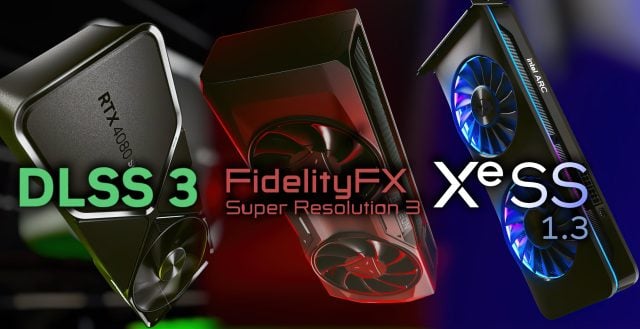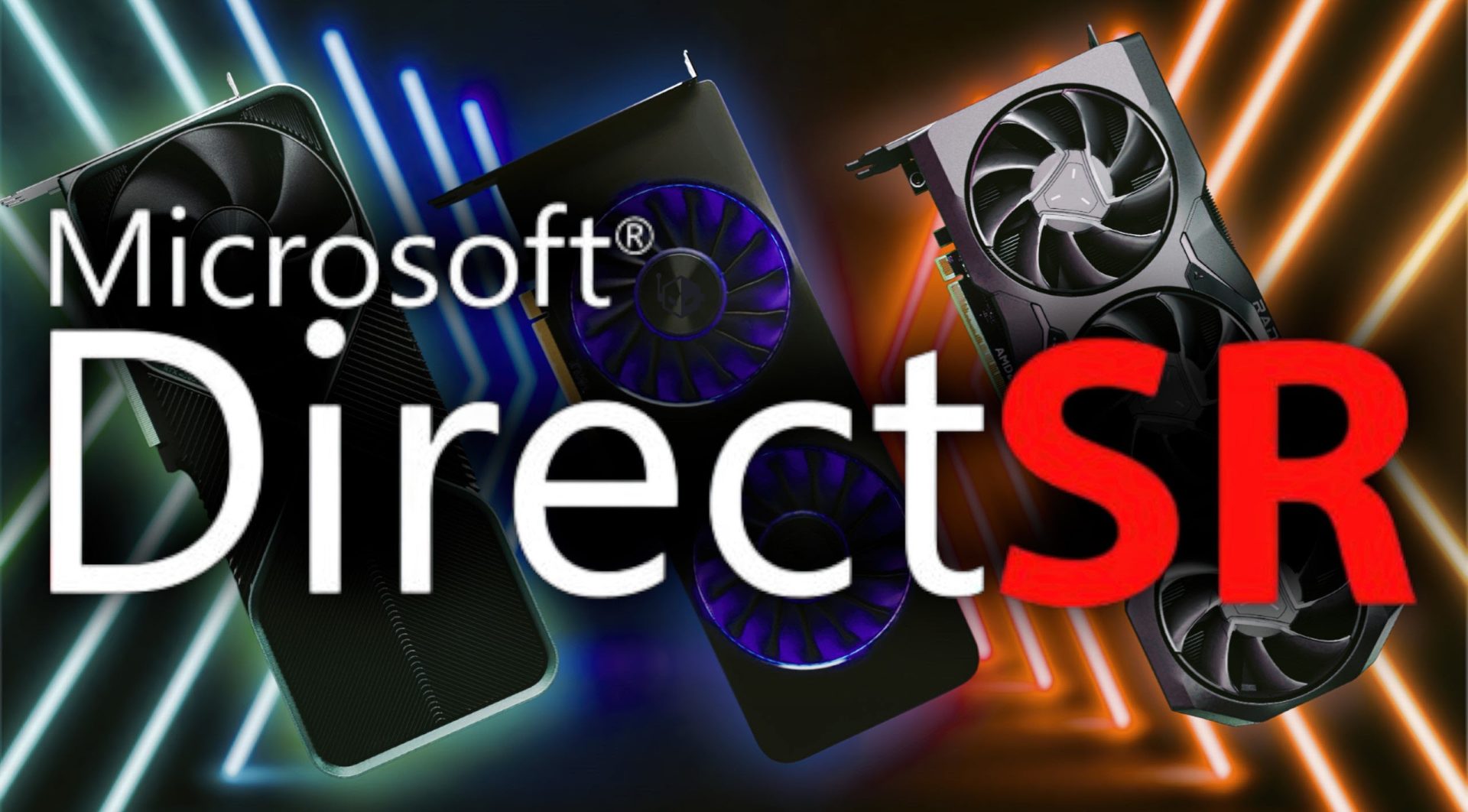DLSS, FSR and XeSS in One: What is Microsoft DirectSR?

Software-based image upscaling technologies continue to shape the future of the gaming world. NVIDIA created a huge revolution with its DLSS (Deep Learning Super Sampling) technology. Then AMD created a competitor with the FSR (FidelityFX Super Resolution) solution that can work with different brands of graphics cards. Intel, which was introduced to the external GPU world, also had to do something, so they introduced XeSS (Xe Super Sampling) technology without delay. Each of these upgrade techniques have differences, but basically serve the same purpose. Microsoft announced that it has launched its new API developed in collaboration with AMD, Intel and NVIDIA: DirectSR.
The solution, called DirectSR, will allow DLSS, FSR and XeSS to be seamlessly integrated into DirectX 12 games with a single code path. Game developers will be able to easily integrate all three upgrade technologies into their games. In this way, we, the players, will be able to use upgrade technologies in more games. Now we hope that we will see at least one different image scaling setting in almost every game, and in some, three different image scaling settings.
DirectSR, which stands for Direct Super-Resolution, is now available through Microsoft’s Agility SDK 1.714.0 preview release, which includes built-in FSR 2.2 support. DirectSR support for DLSS and XeSS is available through the latest drivers from NVIDIA and Intel. The new API also supports third-party upgrade solutions over the Microsoft version of the NVIDIA Streamline SDK and DLSS. Thanks to Microsoft’s API, upgrade solutions developed by AMD, Intel and NVIDIA will be combined under a single interface.
This interface reduces the amount of work developers need to do to integrate DLSS, FSR, and XeSS into their games. In the past, with the exception of game engines with upgrade-specific plugins such as Unreal Engine 5, each upgrade solution had to be implemented manually with separate SDKs. With DirectSR, all three technologies can be implemented in a single move.
What is DirectSR?
DirectSR is a new API designed to standardize super resolution (SR) support in Direct3D 12 games. Microsoft has provided an important service to developers and gamers by gathering all competing technologies under one flag. The company collaborated with AMD, Intel, and NVIDIA to create this API, allowing developers to seamlessly leverage in-market upgrade technologies through a common set of inputs and outputs.
SR integration is simplified by providing a single code to use DLSS Super Resolution, FidelityFX Super Resolution and XeSS. Technically, DirectSR’s functionality was already available in NVIDIA’s Streamline SDK, which has been on the market for two years. But it hasn’t yet been widely adopted for integrating anything other than DLSS. Since DirectSR is based on the DirectX 12 pipeline, it has a much higher potential to attract developer attention.

Since DirectSR is technically an alternative loading method for integrating DLSS, XeSS, and FSR, Microsoft’s new API needs to be supported at the graphics driver level for hardware-specific upgrade solutions. Microsoft says DirectSR will have built-in support for GPU-independent upgrade variants and will not require GPU driver updates. In the latest preview of the new method, Microsoft only added built-in support for FSR 2.2. But we expect Microsoft to add built-in support for Intel’s DP4a, the GPU-independent version of XeSS, in a future update (possibly a full release).
It’s great to see developers getting easier accessibility and more modern integration for all three upgrade solutions. DirectSR will inevitably contribute to the increasing adoption of upscaling solutions in modern video games, especially DirectX 12 games. We expect DirectSR support to be integrated into both new/upcoming games and existing games. However, we do not expect widespread adoption of DirectSR until the API is fully released.
Actually, everything is clear, but let’s give a brief summary. Microsoft’s new service is an image processing technology that uses machine learning algorithms to increase the resolution and quality of images. By utilizing deep learning techniques, DirectSR can upscale low-resolution images to higher resolutions without compromising image details.
Things are going well on the DirectX side, but unfortunately there is no DirectSR equivalent solution on the Vulkan side. GPU giants that Microsoft works with said hello to the new technology with the following words:
“We were pleased to collaborate with Microsoft on the design and development of DirectSR as a way to unify developer access to super-resolution technologies across all platforms. We’re excited to have AMD FSR 2.2 available as a built-in implementation in DirectSR as part of this preview release.”
-Andrej Zdravkovic, Senior Vice President of GPU Technologies and Engineering Software and Chief Software Officer, AMD
“Intel strongly supports Microsoft’s DirectSR specification and the collaborative efforts in creating this specification – DirectSR makes life easier for game developers and enables more gamers to experience Intel’s XeSS scaling technology on Intel GPUs.”
-Alexander Kharlamov, Senior Director, Intel GPU Rendering
“NVIDIA DLSS Super Resolution is available in more than 400 games and has become a standard feature for gamers. We’re excited to offer developers more ways to bring DLSS to next-generation games.”
-Jason Paul, VP of GeForce Platform Marketing at NVIDIA
How Does DirectSR Work?
Rather than a true upscaling technology, DirectSR is an API that allows Windows game developers to more easily incorporate multiple existing upscaling solutions. So, thanks to DirectSR, if any developer wants to include NVIDIA DLSS, AMD FSR or Intel XeSS in the game to increase the frame rate, they will be able to do so with much less effort.
This will allow more PC games to benefit from the upgrade features. FPS will increase to very high levels and our gaming experience will improve. As a result, there is nothing we, the users, need to do in particular. We will only make the necessary driver updates, if the technologies are applied to games we will be able to easily activate them from the settings.
If you ask how image upscaling solutions work, it is by using an artificial neural network trained on a large dataset of high-resolution images. When presented with a low-resolution image, the neural network analyzes the image and fills in the missing details, creating a high-resolution version. Thanks to this process, DirectSR can produce images with better sharpness, clarity and overall quality.
Potential Benefits of DirectSR
- Improved visual quality: Thanks to the technologies incorporated into games, DirectSR has the potential to significantly improve the visual quality of images, making them look more detailed and realistic. This can be especially useful for industries such as photography, graphic design and advertising, where high-quality images are crucial.
- Improved image analysis: DirectSR could also have a positive impact on industries that rely on image analysis, such as medical imaging and satellite imagery. By increasing the resolution and quality of images, it can help medical professionals and researchers better analyze and interpret medical scans or satellite images, resulting in more accurate diagnoses and insights.
- Improved user experience: In industries involving image-based applications such as virtual reality, gaming, and augmented reality, DirectSR can greatly improve the user experience. By providing higher resolution and more detailed visuals, it can create a more immersive and realistic environment for users.
- Efficient storage and transmission: DirectSR can also play a role in optimizing the storage and transmission of images. By upscaling low-resolution images to higher resolutions, it can reduce the file size of images without sacrificing quality. It can be particularly useful in scenarios where limited storage or bandwidth is involved, such as online image galleries or streaming platforms.
DirectSR Support
Native support for DirectSR is provided through GPU drivers where developers tune their SR applications for optimal hardware performance. Additionally, DirectSR includes built-in support for GPU-independent variants that can be used at the application level, making it accessible across hardware configurations. Microsoft said the new solution is launching with built-in support for AMD FidelityFX Super Resolution (FSR) 2.2, as well as driver-level support for both Intel XeSS and NVIDIA DLSS Super Resolution. Thanks to this flexibility, support for many graphics cards will be provided.
One of the most exciting features of DirectSR is that it allows users to choose between available amplifiers at runtime, depending on their underlying hardware. So we, the players, will be able to choose the SR solution that best suits our system and get the best experience.
What’s more, DirectSR is a standalone solution, eliminating the need for developers to integrate SDKs or vendors to bundle libraries with their games. This simplifies the integration process and makes SR support more accessible.
Developers can now get started via Agility SDK 1.714.0-preview release. Support for integrated graphics and external Arc graphics cards on Intel’s 11th Generation Intel Core processors with latest drivers provided. On the NVIDIA side, built-in DLSS Super Resolution support has been added for GeForce RTX 2000 series or newer graphics cards. 560.38 Version number has this support.

